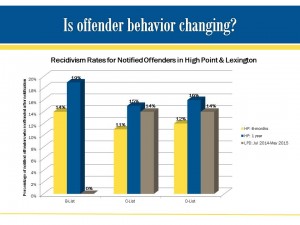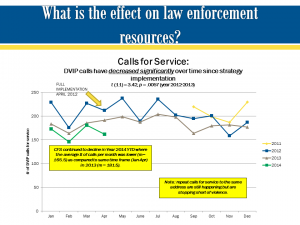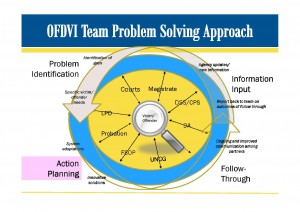Domestic Violence
Offender Focused Domestic Violence Initiative
The North Carolina Network for Safe Communities (NCNSC) at UNCG received COPS funding to conduct a full impact evaluation of the Offender Focused  Domestic Violence Initiative in High Point, NC along with evaluation and T/TA of the strategy as it is replicated in Lexington, NC.
Domestic Violence Initiative in High Point, NC along with evaluation and T/TA of the strategy as it is replicated in Lexington, NC.
Evaluation esults suggest that victim harm, volume of domestic-related arrests and calls for service, and domestic violence offender recidivism have all decreased in High Point since the strategy began in February 2012. For the full evaluation and implementation report from the NCNSC research team (Sechrist, Weil, & Shelton, 2016), click: COPS OFDVI Lexington – High Point Evaluation – FINAL
The graphic to the right demonstrates the recidivism rates in both High Point and Lexington for domestic violence offenders who have received a notification message.

NCNSC presented along with partners at Lexington Police Department on the one-year outcomes in Lexington, NC to the domestic violence initiative working group partners and the larger community. At this celebrated occasion, in July 2015, two victims shared their experiences of how the criminal justice system has responded to their needs much more effectively since the domestic violence initiative has been implemented. One victim in particular was able to share the story of how she was treated by law enforcement officers who responded to her call for service in another jurisdiction. The officers were dismissive, insensitive, and nothing was done to her offender. She stated that officers even made jokes about the incident while at the scene. When the same victim shared the response she received in Lexington, she was very grateful to law enforcement and was overwhelmed by the positive and proactive response she received– eventually resulting in her offender being jailed and held accountable for his actions. In addition to the successes told by the victims, a representative from Child Protective Services in the Department of Social Services spoke about how through the initiative, partners have worked together more closely and through the partnership, responses to child-involved incidents of domestic violence have become more effective. Lexington is now touting an approximate 14% recidivism rate for notified domestic violence offenders and a victim injury rate in domestic violence incidents that is lower than the national average. To access a copy of the presentation, click: LPD 2015 One Year Update Presentation.
Also, NCNSC has released an interim analysis of domestic violence offenders who have been notified through the High Point Police Department’s focused deterrence initiative. The findings from the analysis reveal that we know quite a bit how well the strategy is working in reducing domestic violence recidivism and with what types of offenders.
First of all, in general, the strategy of notifying domestic violence offenders that the police department now has a new way of dealing with domestic violence and is taking domestic violence crimes seriously works to deter future domestic violence recidivism.
The notification message goes onto to say that we [the police department] know who you are and you are now on a list being tracked for any future domestic violence offenses. Further domestic violence will result in swift, certain, and severe consequences. The offender’s anonymity is stripped and the offender is told that the victim is no longer driving the process. The police department is now taking charge. A seemingly simple concept has had rather astounding results when compared to traditional approaches to deter domestic violence. The graph below from the interim report shows the 6-month and 1-year recidivism rates for notified offenders across offender categories in High Point.We have found that certain offenders are more likely than others to recidivate after notification at both the C and D levels.
First, the domestic violence history of an offender matters in whether or not they are likely to reoffend after notification. For both C- and D-level offenders, if they had a prior arrest for domestic violence before notification, they were more likely to reoffend after notification than offenders who did not have a prior domestic violence arrest. Therefore, it helps to know who is being notified based on their past arrest history and there may be room for adjusting the notification message or delivery method to account for past history in hopes of making the notification more successful in deterring future domestic violence for high-risk offenders. While most C-notified offenders (82.7%) did not reoffend after notification, 17.3% did reoffend. When looking at the C-level reoffenders, 60% had a prior domestic violence arrest before notification compared to only 32% of offenders who did not reoffend after C-notification. C-list reoffenders also had significantly more total domestic violence arrests prior to C-notification (1.35 prior domestic violence arrests on average) compared to non-reoffenders (.67 prior domestic violence arrests on average). A similar trend was found for D-notified offenders. Most D-notified offenders (77.6%) did not reoffend after notification with reoffenders being slightly more likely than non-reoffenders to have had a prior domestic violence arrest before notification.
Age of the offender at the time of their 1st domestic violence arrest is important in predicting whether the offender will reoffend after notification. Non-reoffenders were statistically significantly older at the age of first domestic violence arrest as compared to reoffenders. The average age of first domestic violence arrest for C-level reoffenders was 30.1 years which was significantly younger than non-reoffenders whose average age of first domestic violence arrest was 32.5 years. However, there was no significant difference between age at notification for C-list reoffenders and non-reoffenders. For D-list offenders, age at notification was associated with whether or not the offender reoffend after notification. D-notified reoffenders tended to be slightly younger at time of notification (average age at notification was 33.1 years) compared to non-reoffenders (average age at notification was 36.2 years). Like with the C-list trend, D-list reoffenders tended to be younger at age of first domestic violence arrest (average age was 30.9 years) compared to non-reoffenders (average age was 33.0 years). See the graphic below from the interim report for more detail.
Certain offenders reoffend very quickly after notification and they are very likely to reoffend again as they escalate up the offender notification categories. Specifically, if an offender quickly reoffended after D-notification (defined as getting a new domestic violence arrest within 180 days of initial notification), they were more likely to reoffend again after C-notification as compared to D-notified offender who were not quick reoffenders. 38% of Quick Reoffenders after D-notification went onto to reoffend after C notification. See graph below from the interim report for more details.
What do we do now with what we know?
- Can we take advantage of this knowledge based on what the data shows us about reoffenders to change the messaging or process in some way to better deter high risk offenders?
- Other potential risk factors for reoffense after notification were: 1) being male, 2) being young, especially for C-list offenders, and 3) being an offender who qualified for D notification, but could not be located or otherwise reached to receive the D notification message.
- What can be done to ensure that no offenders who should be notified fall through the cracks? In order for this strategy, or any focused deterrence strategy to be successful, offenders must be met with certain, severe, and swift consequences for their offending behavior.
The full interim report can be accessed here: Nov 2014 Interim Report_UNCG Notified Offenders OFDVI Evaluation
Background of the Strategy
The High Point Police Department in partnership with the High Point Community Against Violence, Guilford County District Attorney’s Office, Family Service of the Piedmont, and researchers at the University of North Carolina at Greensboro have implemented a focused deterrence strategy to combat domestic violence. The initiative known as, Offender Focused Domestic Violence Initiative (OFDVI) has been in effect for over three years beginning in February 2012. The low recidivism rates for domestic violence offenders after OFDVI implementation are staggering given the recidivism rates for domestic violence offenders presented in the literature, which range from 20-34% (Hanson, Helmus, & Bourgon; Hendricks, Werner, Shipway, & Turinetti, 2006; McCormick, Cohen, & Plecas, 2011; Ventura & Davis, 2001; Williams & Houghton, 2004) with the majority occurring within six months of their initial assault.
The OFDVI strategy represents for the first time anywhere, the application of the evidence-based focused deterrence approach to the problem of domestic violence and a shift to an offender focus in combatting domestic violence. With the OFDVI approach, law enforcement and resource efforts are focused on those offenders who are identified by level of interpersonal violence, frequency of violence, and an analysis of their legal exposures, and these offenders are notified that their violent behavior will no longer be tolerated and what the specific sanctions will be for those who reoffend after notification. By focusing on the offender, the OFDVI strategy attempts to avoid re-victimization of victims by alleviating systematic barriers in the judicial process.
More Evaluation Results/Preliminary Findings
Click here to download a May 2014 presentation about the OFDVI strategy and most up-to-date evaluation results: NCCADV 2014 Conference Presentation
here to download a May 2014 presentation about the OFDVI strategy and most up-to-date evaluation results: NCCADV 2014 Conference Presentation
Click here to download a February 2014 presentation about the OFDVI strategy: Innovations 2014 Conference Presentation FINAL
Click here to download a November 2013 presentation to the American Society of Criminology: ASC 2013 Conference Presentation FINAL
Changes in Process Responses to Domestic Violence
To shift the focus to the offender, the OFDVI strategy is designed to address issues or gaps within the criminal justice system itself that has socialized domestic violence offenders to perceive that they will receive only minor consequences for their offenses, and has led offenders and victims to believe that domestic violence is not an issue of importance to the criminal justice system and the community. As these perceptions become reality for many offenders and victims, the lack of swift and certain consequences has emboldened offenders to continue with their violence and escalate their behavior over time which could result in serious injury or even death for victims.
To enact change in the criminal justice system’s response to domestic violence, there have been changes in the attitudes and behaviors of key players in the system, specifically the  courts and law enforcement personnel who deal with the perpetrator. The OFDVI strategy is built upon a partnership designed to enact change at all levels of the system through constant monitoring of the system, ongoing feedback from parties involved in the system, and a willingness of system players to be open to criticism and be willing to change or affect change in others. See graphic to the right. One of the critical features of the OFDVI strategy is the ability to focus on offenders by targeting them at earlier stages of offending, before the secrecy of offending entrenches and the violence escalates, is a unique and important facet, particularly since research suggests that early intervention is key in stopping the cycle of domestic violence.
courts and law enforcement personnel who deal with the perpetrator. The OFDVI strategy is built upon a partnership designed to enact change at all levels of the system through constant monitoring of the system, ongoing feedback from parties involved in the system, and a willingness of system players to be open to criticism and be willing to change or affect change in others. See graphic to the right. One of the critical features of the OFDVI strategy is the ability to focus on offenders by targeting them at earlier stages of offending, before the secrecy of offending entrenches and the violence escalates, is a unique and important facet, particularly since research suggests that early intervention is key in stopping the cycle of domestic violence.
The implementation process documentation prepared by NC Network for Safe Communities is available here: OFDVI Process Documentation FINAL







